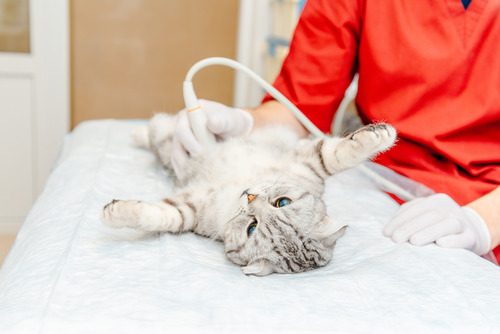Causes and Treatment for a Urinary Blockage in Cats

A urinary blockage in cats is a serious, potentially life-threatening condition that requires prompt medical attention. This blockage prevents the normal flow of urine, causing painful and potentially dangerous complications. As a pet parent, it’s crucial to recognize the signs and symptoms early, understand what causes urinary blockages, and know the treatment options available. In this blog, we’ll take a detailed look at the causes of urinary blockages in cats, the symptoms to watch out for, and the treatments that can help restore your cat’s health. Keep reading to learn more about this critical condition and how Happy Tails Emergency Veterinary Clinic can help.
What is a Urinary Blockage in Cats?
A urinary blockage in cats occurs when there’s a physical obstruction in the urinary tract, preventing urine from being expelled from the body. This can happen at various points along the urinary system, but most commonly occurs in the urethra, the tube that carries urine from the bladder out of the body.
When this blockage occurs, the urine builds up in the bladder, which can lead to bladder rupture, kidney damage, or even kidney failure if left untreated. Male cats are more prone to developing urinary blockages than females, as their urethras are longer and narrower. This makes it harder for an obstruction to pass through.
Common Causes of Urinary Blockages in Cats
Urinary blockages in cats can be caused by a variety of factors. Let’s take a closer look at the most common causes of this condition.
Uroliths (Urinary Stones)
One of the most common causes of a urinary blockage in cats is the presence of uroliths, or urinary stones. These are hard, mineral deposits that form in the bladder or urethra. They can vary in size and shape, and depending on where they form, they can obstruct the flow of urine. Uroliths can be made up of several types of minerals, including struvite and calcium oxalate.
Struvite stones are most common in female cats, while male cats tend to develop calcium oxalate stones. These stones can cause irritation and pain in the urinary tract, and if left untreated, they can create a blockage, making it difficult or impossible for the cat to urinate.
Feline Idiopathic Cystitis (FIC)
Feline idiopathic cystitis (FIC) is a condition that affects the bladder and causes inflammation, often leading to urinary blockages. The exact cause of FIC is unknown, but it is believed to be linked to stress, diet, and genetics. Cats with FIC may have inflammation and irritation in the bladder, which can result in the formation of mucus and crystals that may contribute to blockages. In some cases, FIC can cause the bladder to become overly sensitive, resulting in painful urination or difficulty emptying the bladder. This can lead to a urinary obstruction.
Urethral Plugs
A urethral plug is another common cause of urinary blockages in male cats. These plugs are composed of a mixture of mucus, cells, and crystals that form in the urethra. Over time, these substances can build up and cause a complete obstruction, preventing the cat from urinating. Urethral plugs are more common in overweight, male cats, particularly those with a history of urinary tract infections or crystals in their urine.
Trauma or Injury
In some cases, a urinary blockage in cats can result from trauma or injury to the urinary tract. For example, a cat that has been in a car accident or suffered a fall may sustain internal injuries that result in a blockage. Trauma can cause swelling, bruising, or damage to the urethra, making it difficult for the cat to urinate.
Symptoms of a Urinary Blockage in Cats
Recognizing the symptoms of a urinary blockage in cats is crucial. If your cat is experiencing any of the following signs, it’s important to seek immediate veterinary care.
Straining to Urinate
One of the most noticeable signs of a urinary blockage in cats is straining to urinate. Cats may go to the litter box multiple times but struggle to urinate or produce only small amounts of urine. They may also vocalize or show signs of pain during attempts to urinate.
Frequent Litter Box Visits
Cats with a urinary blockage may visit the litter box more often than usual, but are unable to urinate. This is often a sign of discomfort, as their bladder fills up without being emptied.
Blood in the Urine
If you notice blood in your cat’s litter box or on the floor, it could indicate that there’s an obstruction in the urinary tract that’s causing damage to the bladder or urethra.
Lethargy and Loss of Appetite
Cats experiencing a urinary blockage may become lethargic, lose interest in food, and show signs of depression. This occurs because the cat is in pain and uncomfortable. The buildup of toxins in the body can also contribute to a decrease in energy levels.
Vomiting and Abdominal Pain
As the blockage worsens, a cat may begin vomiting or showing signs of abdominal pain. These symptoms occur as a result of the kidneys and bladder becoming overstressed, leading to a build-up of toxins in the bloodstream.
Hiding or Behavioral Changes
When in pain, cats often hide or isolate themselves. If your cat is acting unusually withdrawn, hiding more often, or seems stressed, a urinary blockage could be the cause.
How Is a Urinary Blockage Diagnosed?
Diagnosing a urinary blockage in cats typically begins with a physical exam. During the exam, your veterinarian will check for signs of pain, tenderness, and bladder distension. Blood and urine tests may be conducted to assess kidney function and determine the presence of infection or inflammation. In some cases, an ultrasound or X-ray may be used to identify any stones, plugs, or other obstructions in the urinary tract.
Treatment Approach for a Urinary Blockage in Cats
Treatment for a urinary blockage in cats depends on the severity and underlying cause. However, it typically involves the following steps.
Catheterization
The first step in treating a urinary blockage is usually catheterization. A catheter is inserted into the urethra to clear the blockage and allow urine to flow freely from the bladder. This is often a necessary procedure to relieve the immediate symptoms and prevent further damage to the urinary tract.
Surgery
In cases where catheterization is not successful or the blockage is too severe, surgery may be required to remove the obstruction. For example, if a large stone is blocking the urethra, surgery may be necessary to remove it.
Medications and IV Fluids
After the blockage is cleared, your cat may require medication to reduce inflammation, treat infection, or address any underlying conditions such as FIC or crystals. IV fluids are often administered to help rehydrate your cat and flush toxins from the kidneys.
Dietary Changes
Once the blockage is cleared, your veterinarian may recommend a special diet to help prevent future urinary blockages. These diets are designed to reduce the formation of crystals and stones in the urinary tract and maintain a healthy pH balance in the urine.
What You Can Do to Prevent Future Urinary Blockages
While some causes of urinary blockages in cats are unavoidable, there are steps you can take to help reduce the risk of recurrence.
- Regular Vet Checkups: Routine veterinary checkups are essential for monitoring your cat’s urinary health. Regular exams can help detect early signs of urinary issues and allow for timely intervention before a blockage occurs.
- Proper Hydration and Diet: Encouraging your cat to drink more water and feeding a high-quality, balanced diet can help prevent urinary blockages. Wet cat food is particularly beneficial, as it provides additional hydration and supports urinary tract health.
- Stress Reduction: Since stress is believed to play a role in some urinary blockages, creating a calm, low-stress environment for your cat can be beneficial. This may include providing hiding spots, enriching their environment with toys, and maintaining a consistent routine.
If your cat is experiencing a urinary blockage or you notice any of the symptoms mentioned above, call Happy Tails Emergency Veterinary Clinic at (336) 288-2688 immediately. Our team can help your cat feel better and get back to their healthy, happy self.
Recent Posts
About Us
At Happy Tails Veterinary Emergency Clinic in Greensboro, NC, our kind and knowledgeable team is available to provide gold standard emergency vet care for you and your pet. We’re available in the late night and early morning hours during the week, and 24/7 on weekends for your convenience.
